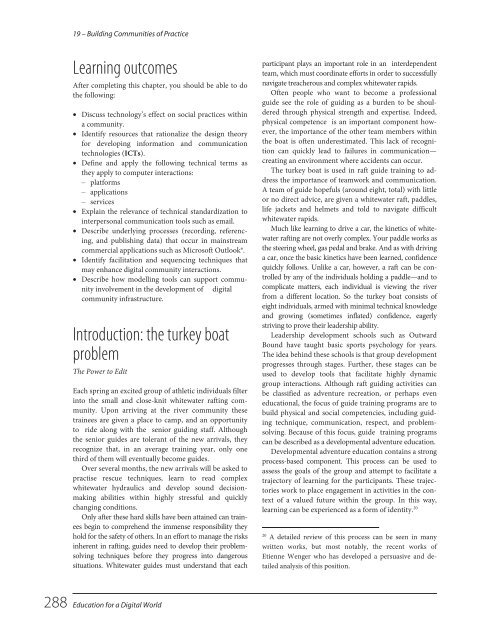Education for a Digital World Advice, Guidelines and Effective Practice from Around Globe, 2008a
Education for a Digital World Advice, Guidelines and Effective Practice from Around Globe, 2008a
Education for a Digital World Advice, Guidelines and Effective Practice from Around Globe, 2008a
Create successful ePaper yourself
Turn your PDF publications into a flip-book with our unique Google optimized e-Paper software.
19 – Building Communities of <strong>Practice</strong><br />
Learning outcomes<br />
After completing this chapter, you should be able to do<br />
the following:<br />
• Discuss technology’s effect on social practices within<br />
a community.<br />
• Identify resources that rationalize the design theory<br />
<strong>for</strong> developing in<strong>for</strong>mation <strong>and</strong> communication<br />
technologies (ICTs).<br />
• Define <strong>and</strong> apply the following technical terms as<br />
they apply to computer interactions:<br />
– plat<strong>for</strong>ms<br />
– applications<br />
– services<br />
• Explain the relevance of technical st<strong>and</strong>ardization to<br />
interpersonal communication tools such as email.<br />
• Describe underlying processes (recording, referencing,<br />
<strong>and</strong> publishing data) that occur in mainstream<br />
commercial applications such as Microsoft Outlook®.<br />
• Identify facilitation <strong>and</strong> sequencing techniques that<br />
may enhance digital community interactions.<br />
• Describe how modelling tools can support community<br />
involvement in the development of digital<br />
community infrastructure.<br />
Introduction: the turkey boat<br />
problem<br />
The Power to Edit<br />
Each spring an excited group of athletic individuals filter<br />
into the small <strong>and</strong> close-knit whitewater rafting community.<br />
Upon arriving at the river community these<br />
trainees are given a place to camp, <strong>and</strong> an opportunity<br />
to ride along with the senior guiding staff. Although<br />
the senior guides are tolerant of the new arrivals, they<br />
recognize that, in an average training year, only one<br />
third of them will eventually become guides.<br />
Over several months, the new arrivals will be asked to<br />
practise rescue techniques, learn to read complex<br />
whitewater hydraulics <strong>and</strong> develop sound decisionmaking<br />
abilities within highly stressful <strong>and</strong> quickly<br />
changing conditions.<br />
Only after these hard skills have been attained can trainees<br />
begin to comprehend the immense responsibility they<br />
hold <strong>for</strong> the safety of others. In an ef<strong>for</strong>t to manage the risks<br />
inherent in rafting, guides need to develop their problemsolving<br />
techniques be<strong>for</strong>e they progress into dangerous<br />
situations. Whitewater guides must underst<strong>and</strong> that each<br />
participant plays an important role in an interdependent<br />
team, which must coordinate ef<strong>for</strong>ts in order to successfully<br />
navigate treacherous <strong>and</strong> complex whitewater rapids.<br />
Often people who want to become a professional<br />
guide see the role of guiding as a burden to be shouldered<br />
through physical strength <strong>and</strong> expertise. Indeed,<br />
physical competence is an important component however,<br />
the importance of the other team members within<br />
the boat is often underestimated. This lack of recognition<br />
can quickly lead to failures in communication—<br />
creating an environment where accidents can occur.<br />
The turkey boat is used in raft guide training to address<br />
the importance of teamwork <strong>and</strong> communication.<br />
A team of guide hopefuls (around eight, total) with little<br />
or no direct advice, are given a whitewater raft, paddles,<br />
life jackets <strong>and</strong> helmets <strong>and</strong> told to navigate difficult<br />
whitewater rapids.<br />
Much like learning to drive a car, the kinetics of whitewater<br />
rafting are not overly complex. Your paddle works as<br />
the steering wheel, gas pedal <strong>and</strong> brake. And as with driving<br />
a car, once the basic kinetics have been learned, confidence<br />
quickly follows. Unlike a car, however, a raft can be controlled<br />
by any of the individuals holding a paddle—<strong>and</strong> to<br />
complicate matters, each individual is viewing the river<br />
<strong>from</strong> a different location. So the turkey boat consists of<br />
eight individuals, armed with minimal technical knowledge<br />
<strong>and</strong> growing (sometimes inflated) confidence, eagerly<br />
striving to prove their leadership ability.<br />
Leadership development schools such as Outward<br />
Bound have taught basic sports psychology <strong>for</strong> years.<br />
The idea behind these schools is that group development<br />
progresses through stages. Further, these stages can be<br />
used to develop tools that facilitate highly dynamic<br />
group interactions. Although raft guiding activities can<br />
be classified as adventure recreation, or perhaps even<br />
educational, the focus of guide training programs are to<br />
build physical <strong>and</strong> social competencies, including guiding<br />
technique, communication, respect, <strong>and</strong> problemsolving.<br />
Because of this focus, guide training programs<br />
can be described as a developmental adventure education.<br />
Developmental adventure education contains a strong<br />
process-based component. This process can be used to<br />
assess the goals of the group <strong>and</strong> attempt to facilitate a<br />
trajectory of learning <strong>for</strong> the participants. These trajectories<br />
work to place engagement in activities in the context<br />
of a valued future within the group. In this way,<br />
learning can be experienced as a <strong>for</strong>m of identity. 20<br />
20<br />
A detailed review of this process can be seen in many<br />
written works, but most notably, the recent works of<br />
Etienne Wenger who has developed a persuasive <strong>and</strong> detailed<br />
analysis of this position.<br />
288 <strong>Education</strong> <strong>for</strong> a <strong>Digital</strong> <strong>World</strong>


















